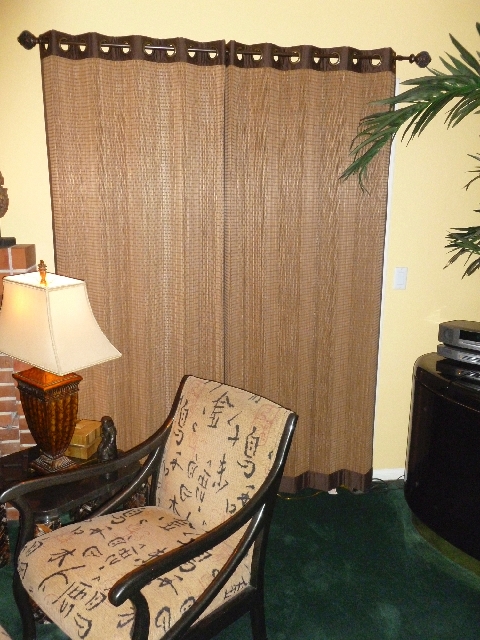Knowing terminology makes dressing windows easier
The voices emanating from the family room at the end of the hallway were muddled at first, but as I made my way across the 24-inch marble squares, I recognized them as my client and Bob, the drapery installer. I couldn’t believe what I was hearing. It seemed like only yesterday that Bob had asked me what I meant by puddling, and here he was talking about that very same effect with my client. “My, he’s sure a quick learner,” I remember thinking to myself as I entered the room.
Apologizing for being a few minutes late (or was it Bob was early?) I launched into my vision for the kind of window treatment that would work best in the space and why. I favored grommets, which are brass or chrome hole reinforcements at the top of a drape or curtain for a more casual look; it is very popular . I knew my client would understand the reasoning behind my choices because she was extremely well versed in the principles of design as well as conversant in the terminology of the interior design profession, and, more precisely, in the language of windows. If she wasn’t, it certainly would have made my work more challenging that day.
Later on, I remember thinking how helpful it is when both practitioner and client, in any field, are familiar with the terminology used in a particular line of endeavor. For example, when I first began working in design the abbreviation “COM” kept coming my way ; I instinctively knew it must be something fundamental and I’d better know what it meant. The term refers to a “customer’s own material,” which means material will be supplied by the client and/or designer in lieu of a fabric offered by the manufacturer.
The puddling, or break, effect of drapery refers to a long drape that falls to the finished floor creating a puddle of fabric that visually breaks the vertical lines of the window treatment and causes a fold in the fabric with a glamorous and elegant look. The bottom of the drapery that lands on the floor should be fluffed by hand for the perfect puddling effect. (I love that look when used appropriately.) Draperies that are made 3 inches too long will create a puddle; the length is generally accepted as an industry standard.
Then you might ask, if puddling works with drapery, does it also work with curtains? And is there any difference between drapery and curtains ? The answer is no and yes.
Curtains may vary in length, while draperies fall all the way to the floor. Draperies also will refer to lined or backed curtains with a fuller and heavier feel. Those are the distinct differences.
If you can’t bring a curtain down to the floor because of some obstacle, then you may want to consider a “hard treatment,” another industry term, such as a blind.
Along with curtains and drapery there’s the option of using Roman or balloon shades. Romans are, simply put, window shades made from fabric that hang flat when down but fold like an accordion when raised. They are more contemporary. Balloons have a softer look and are made of shirred or gathered fabric that’s drawn up into billowy folds. It’s look is more feminine than standard flat Romans and is more at home in a traditional setting.
If these shades are installed inside the window casing (referred to as an inside mount), it will help create a contemporary look in your space. An outside mount refers to a treatment installed outside the window casing, above or to the side of the window. This gives you the opportunity to adjust the height of the treatment; moving it to a high position on the wall creates the appearance of a longer and bigger window.
A fundamental element of any drapery treatment is the lining, which can make all the difference in the world to the aesthetic appeal as well as the durability. The best drapery will feature a lining to protect the fabric from light and dust and an interlining, which is a soft fabric placed between the fabric and lining that provides additional body and insulation.
A tieback, often a braided cord or tassel, will hold the drapery fabric away from the center of the window. The stack refers to the area where the window treatment stacks when drawn open.
If you hear the term drop, it will be in reference to the length of a window treatment from the hanging system to the bottom edge.
Pattern repeat (often very important) is the distance between identical motifs in a pattern. The total repeat is the measurement of one complete design. Knowing the distance between pattern repeats is vital to join a patterned fabric and to determine how much extra fabric to buy.
The leading edge is the sewn fabric edge at the opening of a window treatment and is often accented with a contrasting fabric or trim. Bottom hems tend to be a standard 3 inches, but anything larger will give your drapery a luxurious look.
Finally, railroading refers to turning fabric on its side so that the width becomes the length. This helps to eliminate seams, which can be very helpful for sewing cornices, the panels that cover curtain rods.
The return is the measurement from the front of the rod to the wall.
It really does require a knowledge of certain terminology to successfully translate your vision into the right look for your décor. With or without a designer, you’ll do better when versed in the language of windows.
Stephen Leon is a licensed interior designer and president of Soleil Design; he has been designing and manufacturing custom furniture and cabinetry for more than 25 years. He is president-elect of the Central California/Nevada Chapter of the American Society of Interior Designers and is a certified professional in green residential design. Questions can be sent to soleildesign@cox.net.


















